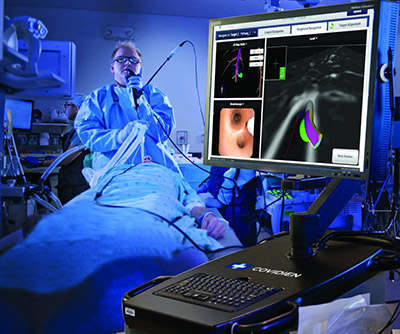Photo provided by Medtronic Covidien.
(Oneida, NY – March 2015) Oneida Healthcare, as part of its comprehensive lung health program, now offers a minimally invasive procedure that may aid with earlier diagnosis for patients with lung lesions, so those with cancer can get treated as soon as possible and patients with benign conditions can potentially avoid surgery.
Dr. Pedro Del Pino and an Oneida Healthcare surgical team recently launched the hospital’s Navigational Bronchoscopy program. Oneida Healthcare is the only hospital in the Mohawk Valley region using this technology to navigate inside a patient’s lungs. All four initial cases were completed within one hour, including pathology analysis, and the surgical team won high praise, with one observer noting: “Their efficiency and excellence would be envied by other facilities throughout New York.”
These Electromagnetic Navigation Bronchoscopy procedures, also known as ENB procedures, which are performed with a device known as the superDimension™ navigation system with LungGPS technology, allow physicians to navigate and access difficult-to-reach areas of the lung from the inside.
Lung cancer accounts for about 27 percent of all cancer deaths and is by far the leading cause of cancer death among both men and women. Each year, more people die of lung cancer than of colon, breast, and prostate cancers combined. Smoking is a major risk factor for developing lung cancer. Oneida Healthcare’s Lung Cancer Screening Program provides low-dose lung CT screening to current and former smokers who are at a high risk for developing this disease. Finding the disease early drastically improves survival rates. Early stage lung cancer that is detected, diagnosed and immediately treated has survival rates up to 88 percent compared to current 15 percent survival rates for late stage lung cancer patients.
“The superDimension navigation system, with GPS-like technology, is a significant advancement for aiding in the diagnosis of lung cancer and overcomes limitations of traditional diagnostic approaches including bronchoscopy, needle biopsy and surgery,” said Dr. Del Pino. “By guiding us through the complicated web of pathways inside the lungs, we’re able to access and sample target tissue throughout the entire lung without surgery or a needle biopsy. This technology can aid with earlier diagnoses which may allow for less invasive treatments for patients with lung cancer.”
Del Pino explained that, even with today’s advances, many physicians still rely on traditional methods that can be limiting or assume greater risk to the patient. Traditional bronchoscopy is only effective in the upper portion of the lungs, while needle biopsies can cause a collapsed lung. Some patients even have to undergo traditional open surgery – which requires a large incision, broken ribs and a long recovery time – just to find out if the lesion was cancerous or not.
“With the superDimension system, we use CT scan images to create a roadmap of the thousands of tiny pathways inside the lungs. The LungGPS technology then allows us to guide tiny tools through the lung pathways so we can take tissue samples of the lesion and place markers for future treatment, and all in a minimally invasive, outpatient procedure,” Del Pino concluded.
For more information on Oneida Healthcare’s Lung Health Program, visit www.oneidahealthcare.org.


